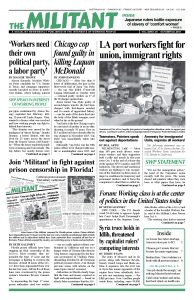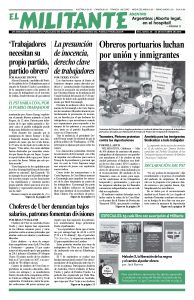Amazon, the second-largest employer in the U.S. after Walmart, and the richest, valued at over $1 trillion, announced Oct. 2 that it’s increasing its minimum wage to $15 an hour starting in November. The move comes in face of a shortage of workers to hire for its huge warehouses and growing discontent by those currently employed there over working conditions — and discussions over unionization.
The move will affect 250,000 full-time Amazon employees and more than 100,000 temporary workers in the U.S. as well as some 37,000 full-time and seasonal workers in the U.K. The raise for U.K. workers will be to $12.50 an hour and in London, $13.80.
In praising the decision as something “new” and “different,” Amazon chief executive Jeff Bezos, currently the richest person in the world and the owner of the Washington Post, didn’t mention the fact that he makes $4 million an hour, a product of the huge profits the company makes off exploiting its workforce.
Competition has been intensifying more broadly over getting and keeping workers to fill lower-paid retail, warehouse and other blue-collar jobs. Earlier this year Walmart increased its minimum wage in the U.S. from $9 to $11.
“It’s no longer enough to post jobs on websites,” Chris Beckage, a vice president of staffing firm Acara Solutions told the Wall Street Journal, to attract workers for warehouse jobs. “We’re going to bowling alleys, churches, community centers.” And some employers are dispensing with marijuana tests and criminal background checks to more quickly get workers on the job, he said.
Amazon’s move follows widespread strikes by workers at the company’s warehouses in Germany and Spain this summer over low pay and working conditions. A one-day strike at six facilities in Germany July 17 coincided with Amazon’s Prime Day, when the company offers big discounts. Workers in Spain went out for three days, and in Poland workers staged a “work-to-rule.”
Amazon Prime, the company’s two-day delivery option, currently costing $119 a year, “has triggered an arms race among the largest retailers,” noted the Wall Street Journal Sept. 20, as sharpening competition has forced many of them to take similar steps. In the past year, Target, Walmart and many vendors on Google Express have started offering similar two-day delivery.
Amazon employs over 560,000 workers worldwide, operating over 140 fulfillment centers — about 75 of them in the U.S. Some of these distribution centers are gargantuan, exceeding a million square feet. And inside its Rube Goldberg-like conveyer systems, speedup and unsafe conditions for the workers increases amid intense boss pressure to “make rate.” Workers also have to contend with the more than 100,000 robots buzzing around Amazon’s distribution centers.
At an Amazon fulfillment center in Pennsylvania, for example, one worker was fired five weeks after getting injured on the job, reported the Guardian. “I was on a ladder and someone came flying into the area I was in, hit the ladder causing me to fall, and I landed on my back and left leg,” Christina Miano-Wilburn told the paper. “They refused to give me paperwork for workmen’s comp.” She had worked at Amazon for two years.
Lindsai Johnson quit her job at a California warehouse last May after having to be taken away in an ambulance over dehydration and dizziness. “Not all people report injuries because they are scared to get taken off their job,” she told the Guardian. “I have many times come home with bruises from work at Amazon and experienced my first hernia there.”
Despite the current expansion in the U.S. capitalist economy, wage raises have been hard to come by. In August wages rose 2.9 percent from a year earlier, but after adjusting for inflation, the increase was just 0.2 percent, the Labor Department reported.
Many bosses instead have opted for offering bonuses or some benefits, something much easier than wages for them to cut when the inevitable capitalist downturn arrives. “The average worker received 32 percent of total compensation in benefits,” reported the New York Times Sept 26, “including bonuses, paid leave and company contributions to insurance and retirement plans in the second quarter of 2018. That was up from 27 percent in 2000.”
But not Jeff Bezos. After announcing the wage hike at Amazon, he said all worker bonuses and stock options were being eliminated to free up money to cover the increase. When workers heard of the cuts, many said they expected they would actually get less over all.

